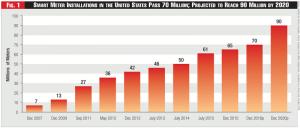IEI's Latest White Paper
Lisa Wood is vice president of the Edison Foundation and executive director of the Institute for Electric Innovation, IEI. At IEI, she collaborates with a management committee of more than twenty electric company CEOs and a select group of technology companies, and provides thought leadership on current issues, trends, and innovation in the electric power industry.
The electric power industry is leading a profound transformation that is being driven by a number of factors - technology, policy, and customers. The technology revolution in energy is a given! Technology changes what we can do, how we do it, and what it costs - and the energy grid is no exception.

The U.S. electric power industry is investing more than a hundred billion dollars each year in smarter energy infrastructure to enhance the reliability, resiliency, and security of the energy grid. Those investments will help integrate and manage more renewables, distributed energy resources, and other devices and improve the efficiency and optimization of the energy grid.
The Institute for Electric Innovation's latest white paper, "Grid Modernization Technologies: Key Drivers of a Smarter Energy Future," discusses electric company investments in smarter energy infrastructure from the substation to the customer meter. They are largely digital technologies that are the building blocks of the future energy grid.
For example, today, more than seventy million digital smart meters are deployed across the U.S., giving more than fifty-five percent of all U.S. households more control and flexibility over their energy use.
The technology upgrades to the distribution grid that electric companies have made over the last ten years have avoided millions of power outages, saved millions of customer dollars by improving system operations, and changed the way electric companies communicate with their customers.
 Figure 1 - Smart Meter Installations in the United States Pass 70 Million; Projected to Reach 90 Million by 2020
Figure 1 - Smart Meter Installations in the United States Pass 70 Million; Projected to Reach 90 Million by 2020
Advanced energy grid technologies allow electric companies to automate important parts of distribution operations to improve reliability and resiliency and to improve outage management and restoration times.
Outage management systems, for example, combine geospatial information systems, customer information systems, and an automated call handling system to prioritize and direct service restoration crews in the field. That enables them to get power back on faster and more cost-effectively.
Electric company investments in digital technologies also ensure the seamless integration of DERs and enable two-way power and information flows, which enhance grid-edge visibility and diagnostics.
They are paving the way to leverage DERs as energy grid assets.
For example, smart inverters enable intelligent control, aggregation, and dispatch of DERs such as private solar photovoltaics and battery energy storage when capacity or ancillary services are needed.
Digital energy grid technologies also have profound impacts on the way electric companies deliver power to homes and businesses. In addition to enhancing resiliency and reliability and integrating and managing more DERs, intelligent grid devices optimize energy grid operations by improving situational awareness.
For example, power line monitors on the distribution grid assess real-time power line and power quality conditions to detect anomalies such as overloading or line sagging and address them before they become problems.
As the electric power industry invests in technologies to make our energy infrastructure smarter, the role of data analytics is crucial. One of the most important uses of data analytics today is in leveraging asset-level intelligence for predictive maintenance and proactive replacement of critical energy grid infrastructure. Additionally, data analytics are used today to manage outages, integrate DERs, and provide customer solutions.
The electric power industry continues to pave the way toward the smart grid of the future. It is critical that technology investments deliver cost savings and operational efficiencies today and be flexible enough to accommodate the changing conditions of tomorrow. By investing in smarter energy infrastructure and partnering closely with technology companies, electric companies are delivering a smarter energy future.
The white paper is available at http://www.edisonfoundation.net.


